Back Hindi Afrikaans Hindi ALS ህንዲ Amharic Idioma hindi AN Hindisc sprǣc ANG हिन्दी भाषा ANP اللغة الهندية Arabic هندية (لغة) ARY هندى ARZ হিন্দী ভাষা Assamese
| Hindi | |
|---|---|
| हिन्दी, Hindī | |
 The word "Hindi" in Devanagari script | |
| Pronunciation | [ˈɦɪndiː] |
| Native to | India |
| Region | Hindi Belt (Western Uttar Pradesh, Delhi) |
| Total speakers | L1: 345 million speakers of Hindi and various related languages who reported their language as 'Hindi' (2011 census)[1][2] L2: 264 million (2020)[2] |
Early forms | |
| |
| Indian Signing System | |
| Official status | |
Official language in | |
Recognised minority language in |
|
| Regulated by | Central Hindi Directorate[8] |
| Language codes | |
| ISO 639-1 | hi |
| ISO 639-2 | hin |
| ISO 639-3 | hin |
| Glottolog | hind1269 |
| Linguasphere | 59-AAF-qf |
 Distribution of L1 self-reported speakers of Hindi in India as per the 2011 Census | |
 |
| Part of a series on the |
| Hindustani language |
|---|
| History |
| Grammar |
| Linguistic history |
| Accessibility |
Modern Standard Hindi (आधुनिक मानक हिन्दी, Ādhunik Mānak Hindī),[9] commonly referred to as Hindi, is the standardised variety of the Hindustani language written in the Devanagari script. It is the official language of India alongside English and the lingua franca of North India. Hindi is considered a Sanskritised register[10] of Hindustani, which itself is based primarily on the Khariboli dialect of Delhi and neighbouring areas.[11][12][13] It is an official language in nine states and three union territories and an additional official language in three other states.[14][15][16][17] Hindi is also one of the 22 scheduled languages of the Republic of India.[18]
Apart from the script and formal vocabulary, standard Hindi is mutually intelligible with standard Urdu, another recognised register of Hindustani, as both Hindi and Urdu share a core vocabulary base derived from Prakrit (a descendant of Sanskrit).[19][20][21][22] Hindi is also spoken, to a lesser extent, in other parts of India (usually in a simplified or pidginised variety such as Bazaar Hindustani or Haflong Hindi).[14][15] Outside India, several other languages are recognised officially as "Hindi" but do not refer to the Standard Hindi language described here and instead descend from other nearby languages, such as Awadhi and Bhojpuri. Such languages include Fiji Hindi, which has an official status in Fiji,[23] and Caribbean Hindustani, which is spoken in Suriname, Trinidad and Tobago, and Guyana.[24][25][26][27]
Hindi is the fourth most-spoken first language in the world, after Mandarin, Spanish and English.[28] If counted together with the mutually intelligible Urdu, it is the third most-spoken language in the world, after Mandarin and English.[29][30] According to reports of Ethnologue (2022, 25th edition) Hindi is the third most-spoken language in the world including first and second language speakers.[31]
Hindi is the fastest growing language of India, followed by Kashmiri, Meitei, Gujarati and Bengali according to the 2011 census of India.[32]
- ^ "Scheduled Languages in descending order of speaker's strength - 2011" (PDF). Registrar General and Census Commissioner of India. 29 June 2018.
- ^ a b Hindi at Ethnologue (27th ed., 2024)

- ^ a b Hindustani (2005). Keith Brown (ed.). Encyclopedia of Language and Linguistics (2 ed.). Elsevier. ISBN 0-08-044299-4.
- ^ Gangopadhyay, Avik (2020). Glimpses of Indian Languages. Evincepub publishing. p. 43. ISBN 9789390197828.
- ^ Palakodety, Shriphani; KhudaBukhsh, Ashiqur R.; Jayachandran, Guha (2021), "Low Resource Machine Translation", Low Resource Social Media Text Mining, SpringerBriefs in Computer Science, Singapore: Springer Singapore, pp. 7–9, doi:10.1007/978-981-16-5625-5_5, ISBN 978-981-16-5624-8, ISSN 2191-5768, S2CID 244313560, retrieved 24 September 2022
- ^ "Constitution of the Republic of South Africa, 1996 – Chapter 1: Founding Provisions". www.gov.za. Retrieved 6 December 2014.
- ^ "Abu Dhabi includes Hindi as third official court language". The Hindu. 10 February 2019 – via www.thehindu.com.
- ^ "About Us". Central Hindi Directorate. Archived from the original on 4 May 2012. Retrieved 18 February 2014.
- ^ Singh, Rajendra, and Rama Kant Agnihotri. Hindi morphology: A word-based description. Vol. 9. Motilal Banarsidass Publ., 1997.
- ^ "The Constitution of India". lawmin.nic.in. Archived from the original on 2 April 2012. Retrieved 21 March 2012.
- ^ "About Hindi-Urdu". North Carolina State University. Archived from the original on 15 August 2009. Retrieved 9 August 2009.
- ^ Basu, Manisha (2017). The Rhetoric of Hindutva. Cambridge University Press. ISBN 978-1-107-14987-8.
Urdu, like Hindi, was a standardized register of the Hindustani language deriving from the Delhi dialect and emerged in the eighteenth century under the rule of the late Mughals.
- ^ Peter-Dass, Rakesh (2019). Hindi Christian Literature in Contemporary India. Routledge. ISBN 978-1-00-070224-8.
Two forms of the same language, Nagarai Hindi and Persianized Hindi (Urdu) had identical grammar, shared common words and roots, and employed different scripts.
- ^ a b Kawoosa, Vijdan Mohammad (22 November 2018). "How languages intersect in India". Hindustan Times. Archived from the original on 15 October 2022.
- ^ a b "How many Indians can you talk to?". Hindustan Times. Archived from the original on 16 December 2019. Retrieved 22 December 2019.
- ^ Saravanan, Depak (9 October 2018). "Hindi and the North-South divide". Deccan Herald. Archived from the original on 23 November 2022.
- ^ Pillalamarri, Akhilesh. "India's Evolving Linguistic Landscape". The Diplomat. Archived from the original on 1 June 2019. Retrieved 22 December 2019.
- ^ "PART A Languages specified in the Eighth Schedule (Scheduled Languages)". Census of India. Archived from the original on 29 October 2013.
- ^ Gube, Jan; Gao, Fang (2019). Education, Ethnicity and Equity in the Multilingual Asian Context. Springer Publishing. ISBN 978-981-13-3125-1.
The national language of India and Pakistan 'Standard Urdu' is mutually intelligible with 'Standard Hindi' because both languages share the same Indic base and are all but indistinguishable in phonology and grammar (Lust et al. 2000).
- ^ Chatterji, Suniti Kumar; Siṃha, Udaẏa Nārāẏana; Padikkal, Shivarama (1997). Suniti Kumar Chatterji: a centenary tribute. Sahitya Akademi. ISBN 978-81-260-0353-2.
High Hindi written in Devanagari, having identical grammar with Urdu, employing the native Hindi or Hindustani (Prakrit) elements to the fullest, but for words of high culture, going to Sanskrit. Hindustani proper that represents the basic Khari Boli with vocabulary holding a balance between Urdu and High Hindi.
- ^ Yoon, Bogum; Pratt, Kristen L., eds. (15 January 2023). Primary Language Impact on Second Language and Literacy Learning. Lexington Books. p. 198.
In terms of cross-linguistic relations, Urdu's combinations of Arabic-Persian orthography and Sanskrit linguistic roots provides interesting theoretical as well as practical comparisons demonstrated in table 12.1.
- ^ "Ties between Urdu & Sanskrit deeply rooted: Scholar". The Times of India. 12 March 2024. Retrieved 8 May 2024.
The linguistic and cultural ties between Sanskrit and Urdu are deeply rooted and significant, said Ishtiaque Ahmed, registrar, Maula Azad National Urdu University during a two-day workshop titled "Introduction to Sanskrit for Urdu medium students". Ahmed said a substantial portion of Urdu's vocabulary and cultural capital, as well as its syntactic structure, is derived from Sanskrit.
- ^ "How Hindi travelled to these five countries from India". The Indian Express. 14 September 2018. Archived from the original on 29 December 2022.
- ^ "Sequence of events with reference to official language of the Union". Department of Official Language. Archived from the original on 2 August 2011.
- ^ "रिपब्लिक ऑफ फीजी का संविधान (Constitution of the Republic of Fiji, the Hindi version)". Fiji Government. Archived from the original on 1 November 2013.
- ^ "Caribbean Languages and Caribbean Linguistics" (PDF). University of the West Indies Press. Archived from the original (PDF) on 20 December 2016. Retrieved 16 July 2016.
- ^ Richard K. Barz (8 May 2007). "The cultural significance of Hindi in Mauritius". South Asia: Journal of South Asian Studies. 3: 1–13. doi:10.1080/00856408008722995.
- ^ Mikael Parkvall, "Världens 100 största språk 2007" (The World's 100 Largest Languages in 2007), in Nationalencyklopedin. Asterisks mark the 2010 estimates Archived 11 November 2012 at the Wayback Machine for the top dozen languages.
- ^ Gambhir, Vijay (1995). The Teaching and Acquisition of South Asian Languages. University of Pennsylvania Press. ISBN 978-0-8122-3328-5.
The position of Hindi-Urdu among the languages of the world is anomalous. The number of its proficient speakers, over three hundred million, places it in third of fourth place after Mandarin, English, and perhaps Spanish.
- ^ "Hindustani". Columbia University Press. Archived from the original on 29 July 2017 – via encyclopedia.com.
- ^ "What are the top 200 most spoken languages?". Ethnologue (Free All). Retrieved 31 March 2023.
- ^ —R, Aishwaryaa (6 June 2019). "What census data reveals about use of Indian languages". Deccan Herald. Retrieved 16 November 2023.
—Pallapothu, Sravan (28 June 2018). "Hindi Added 100Mn Speakers In A Decade; Kashmiri 2nd Fast Growing Language". Indiaspend.com. Retrieved 16 November 2023.
—IndiaSpend (2 July 2018). "Hindi fastest growing language in India, finds 100 million new speakers". Business Standard. Retrieved 16 November 2023.
—Mishra, Mayank; Aggarwal, Piyush (11 April 2022). "Hindi grew rapidly in non-Hindi states even without official mandate". India Today. Retrieved 16 November 2023.